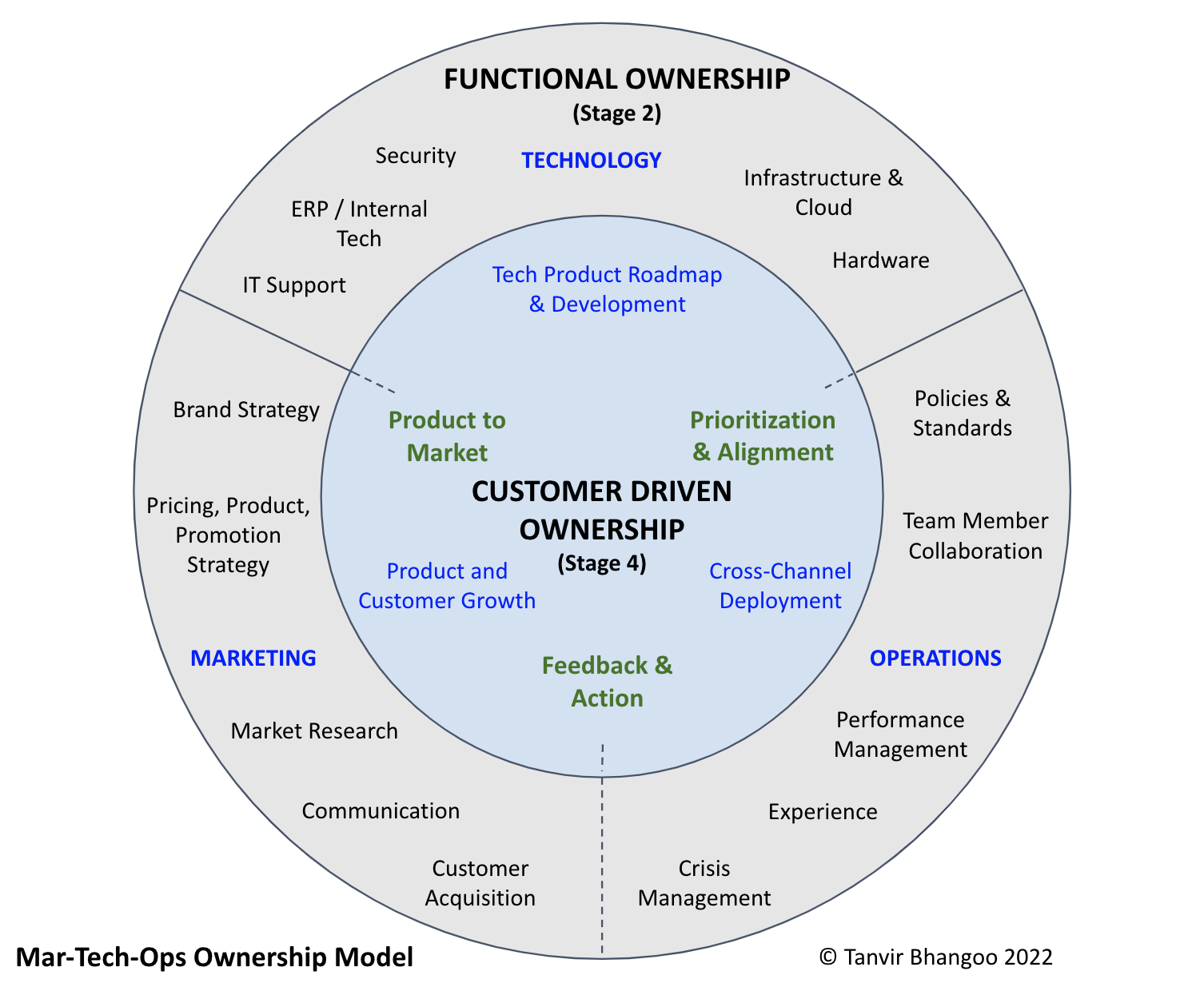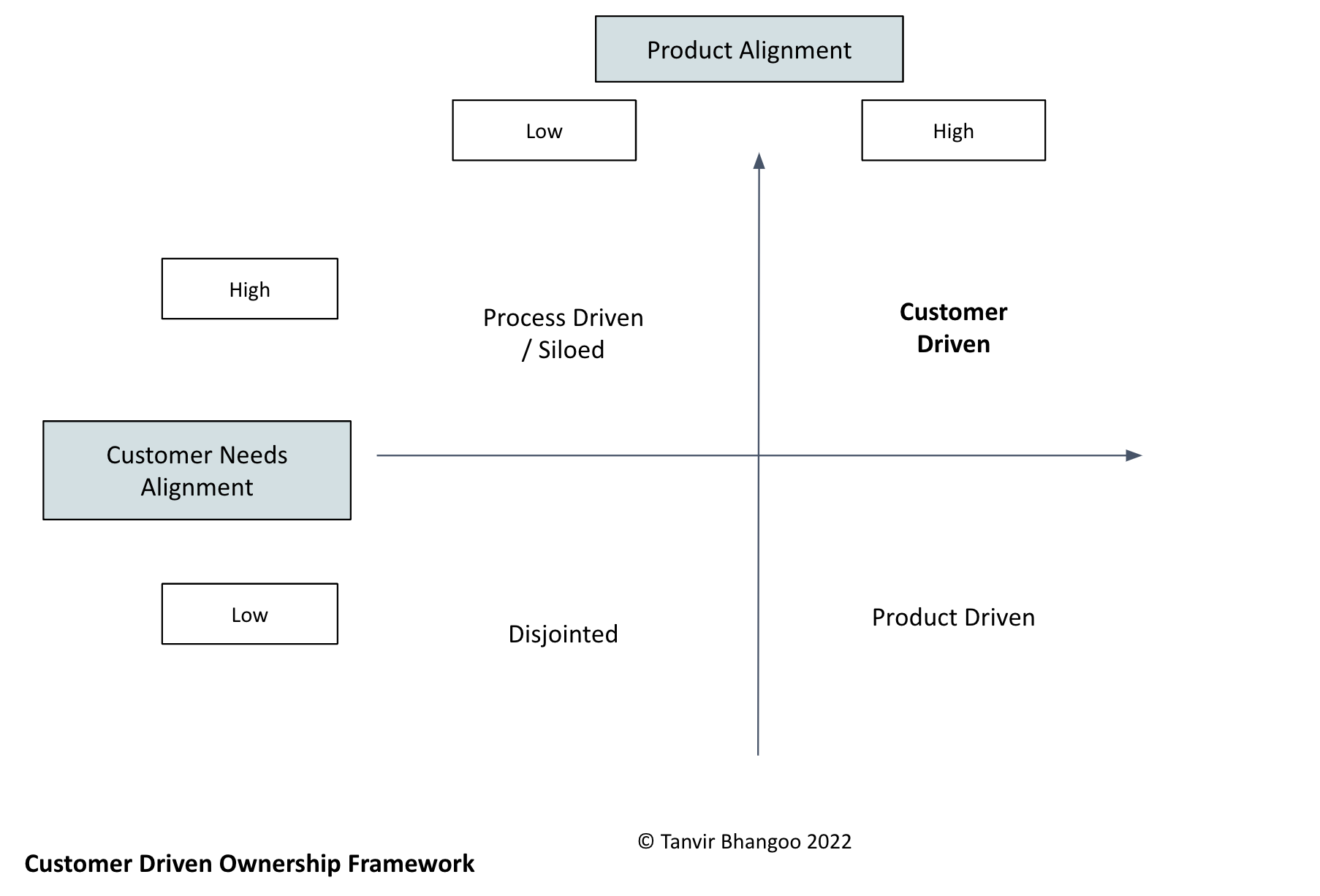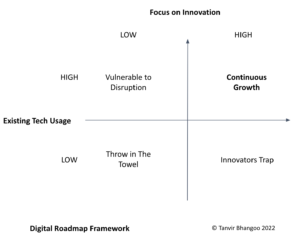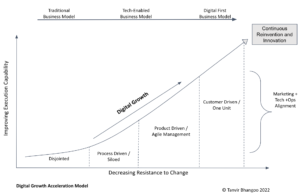I was advising a CEO of a mid-market consumer based company. She told me that as part of their digital efforts, they had a lofty goal of shifting half of their sales to digital channels. The focus was on building out a direct to consumer channel, but progress had been slow.
I asked her how the teams were structured. She said marketing owns the website, tech owns support and ERP, and Ops managed retail stores.
Right then, I knew the problem I had to solve was not a tech problem, but that of alignment and execution between marketing – tech – and ops.
In this article:
I’ll walk through challenges of having a disjointed marketing, tech, & ops function, why they need to integrate and operate at what I call a “Stage 4,” level, and what that may look like in practice in your organization. While this directly applies to consumer and B2C companies on a transformational journey, the core concepts and ideas are applicable to any company or industry that serves customers and is experiencing rapidly changing demands.
Issues with having a disjointed marketing, tech, and ops function.
Before we dive into the 4 stages of mar-tech-ops function, here are some of the symptoms of having a disjointed, or siloed marketing, tech, and ops structure:
- Marketing is always waiting on tech to update the app, or launch a new feature
- Tech (product) team is building products that are not the “highest” priority according to marketing
- It takes more than a week for marketing and tech to reconcile transaction and customer data for an accurate sales and product mix report
- There is always a tech “limitation” to a solution proposed by ops for seamless experience
- Team (product) team is iterating on feedback based on gut feeling vs. customer data
- Store team members tell the customer “our tech team made a change and it messed up your order”
- When something goes wrong, the department heads point fingers
- There are different software and systems that are using by marketing, ops, and tech, that do not talk to each other, and are not shared with other teams
You get the point. All of these issues are a direct result of lack of alignment, structure, and accountability between the three core functions.
Technology vs. IT. vs Product
Before we dive into the four stages, it’s important to understand the difference between tech, product, and IT team. I cringe when someone describes the role of tech as “IT.” or when technology only means “customer facing apps.”
Technology – includes the all encompassing function that oversees, plans, builds, implements, and supports technology at a company.
IT (information technology) – a part of technology function, usually covers the “support and enablement” side of the business. This includes internal technologies (ERP, workplace collaboration, expense reporting, etc.), employee support, cloud infrastructure, analytics integrations, security, etc.
Product (aka digital team) – customer facing, “driver” of business function, covering areas that drive revenue growth. This function either builds or customizes a tech product. Examples include customer facing apps and websites, 3rd party integrations, loyalty systems, team member tools, in store tech (POS), etc.
In other words, within a tech function, the IT team supports, enables and optimizes the business, while the product team drives growth and revenue.
The four marketing – tech – ops ownership outcomes to accelerating digital growth:
Figure 1.
Operating with a product first AND and customer needs mindset allows marketing, tech, and ops teams to drive towards the right goals. In the figure above, if we focus only on product, but neglect the customer needs, we become product driven, and sometimes miss out on the true customer needs and changing demands. If we are only customer focused without a strong pairing of products required to meet those demands, then we become process driven, and each team prioritizes its own actions and outcomes, making for a siloed approach.
The evolution from stage 1 to stage 4:
In my digital growth acceleration model (click here), I discuss 4 major areas that accelerate digital growth. One of those areas is how your marketing, tech, and ops teams are structured, with four varying stages. Let’s dive into them below.
Stage 1: Disjointed
Many companies unfortunately are still operating with this model. This is how marketing, tech, and ops “were” designed to function before the onslaught of digital first businesses and startups. In this model, marketing is a core function, operations only deals with brick and mortar / external experience, and tech is still known as “IT,” and only responsible for support. And unfortunately, this is what we are still being taught in more university courses and by organizational gurus.
Here we see an “IT manager” supporting all areas of the business, including the product side of things (app and web). Instead of having talent and resources aligned towards revenue generating products such as online ordering app and loyalty, with the right talent and capability with a growth oriented strategy, companies still see tech as support. They tend to always play catchup, have a very clunky user experience across all spectrum, and marketing tends to take over and manage apps, websites, and new digital channels.
Example:
As a CEO, when you ask your CMO when can you see the data and results from your recent marketing campaign… The answer is usually “we’re waiting on IT.” While IT is manually pulling reports from 5 different systems as marketing owned websites and apps are not integrated, optimized, and are running on legacy tech that no one knows how to manage.
Stage 2: Siloed or Process Driven:
Most companies within the consumer space fall into this category. The ancient management philosophies of structure and swim lanes are a direct driver of this model. Unfortunately, the speed and chaos at which customer demands change make it hard for this model to achieve digital growth. This instead results in the wrong behaviors, turf wars, and finger pointing, all driven to maximize “individual team’s” growth, while neglecting the overarching mission.
I’ve illustrated the siloed nature of responsibilities in the outer circle of my Mar-Tech-Ops Ownership Model below (figure 2). Usually we see marketing as responsible for core “marketing” activities, tech taking over both IT and product responsibilities, and Ops still being primarily driven by brick and mortar or customer channel responsibilities, and usually has to react to latest innovation or upgrades at the customer or store level. Lack of alignment and information flow between functions make it harder to move at the pace of the customer.
Example:
Marketing buys and implements their own customer data platform, which does not speak to the tech (product) app and web, and requires manual data modelling (usually by IT or finance). Tech launches a new feature on the app that does not address core functionality requirements as per feedback from customers. Operations promised store team members new product and collaboration tools, but these are deprioritized on the tech roadmap.
Figure 2.
Mar-Tech-Ops Ownership Model. The outer circle represents general responsibilities and actions taken by marketing, technology, and ops in a siloed approach. As you can see, there is a lack of product and customer driven accountability to address customers’ changing demands.
The inner circle represents the joint responsibilities of a customer driven approach. The siloed responsibilities remain to best support the business, but part of marketing, tech, and ops integrate to best build products, grow digital channels, and deploy the right programs in a quick and iterative manner.
Stage 3: Product Driven or Agile approach:
A few, handful of leaders in any industry are truly operating under this structure.
In this stage, many of the traditional companies who’ve invested in their transformation actually make a drastic change to restructure their teams to a product line approach. All activities and responsibilities are driven by the core product, for example, a digital ordering app, web, kiosks, etc. This approach aligns efforts across tech, marketing, and ops to build, deploy, and optimize a successful product, versus operating within a defined set of traditional swim lanes.
Here, we have a team that is headed by a product lead or GM, under which you have a marketing function, tech & product development function (either in house or outsourced – a topic for another day), and an operations / customer facing function. This connects the business with the product, and allows teams to deliver the best product experience to their customers to drive revenues and profitability. In other words – it allows companies to quickly build, test, and deploy digital functionality, run customer campaigns, and gather customer feedback to drive digital sales.
Where this model falls short is that your customer does not care what channel they interacted with or made a purchase from – they want what they want, when they want, and how they want – as per their choice – in a seamless, unified, and wowing experience.
Example:
App team builds a customer experience that does not integrate with your in store experience. Marketing teams have a tough time calculating the total cost of acquisition given the systems do not track customers who came in store, but ended purchasing online after seeing an ad on instagram.
Or
Team member at the store tells the customer that this BOGO offer is only valid on the app. (this is usually because the systems don’t speak. A.k.a. different teams working in a silo or heads down on a product first approach, deprioritizing the experience and integrating across systems, made hard by legacy systems.
Stage 4 – Customer Driven Approach (The Utopia):
This is what I call a “customer driven” approach” Similar to the product driven approach, teams sit under one team with responsibilities aligned to a singular goal. I highlight this in the inner circle of the Mar-Tech-Ops Ownership Model shared above.
But instead of aligning to just a product, teams are integrated based on the customer needs across the journey. One team may be responsible for multiple customer needs, but multiple teams will not be responsible for one customer need – or we go back to a product driven approach.
For example, here is a simple customer journey for a retail store:
- Customer builds a need for new shoes
- Customer browses shoes (online, instore, 3rd party channel)
- Customer orders shoes (online, instore, 3rd party channel)
- Shoe order is fulfilled (picked up, curbside, delivered)
- Customer is retargeted for feedback and loyalty points
- Repeat cycle.
In a product driven environment, one team would oversee the app, one team would oversee the web, and the entire customer journey along with it. Many times, some of the journey points may even be neglected, such as fulfillment experience when ordered through the app for pickup, given product and marketing teams are usually focused on activities leading to the sale.
On the contrary, in a customer driven environment, each team owns one or more parts of the customer journey, across all products and channels. A product manager, a digital marketer, an ops deployment leader, and other roles may own just the pre-purchase journey steps (1), or both browsing (2) & ordering (3) steps, across the app, web, instagram, 3rd party retailers, in-store, and even pop-up stores.
This approach truly drives the ever changing experience that customers need – in a unified vision across all channels. We as consumers touch multiple points before making a purchase – we go to a store to try on an item, we compare it on the website, we download the app to make an order and opt-in to the loyalty program – and we expect a unified experience. This approach delivers that exact experience, regardless of the channel.
Example:
Your stage 4, customer driven team, has the systems, analytics, and feedback mechanisms in place to follow the customer across all product touch-points (instagram ads, in store, app, website, Alexa answers), and provide the customer the value that they need to complete their purchase, whether it’s a private booking, a surprise and delight gift, or a bonus loyalty offer.
Conclusion:
Customer driven approach – Stage 4 – is the true customer driven approach, and not merely lip service. If you’re looking to operate in a manner that actually meets your customer demands without internal friction, and is sustainable – this is the structure to strive for.
In my future blog, I’ll touch on how to go from a stage 1 to a stage 4, and steps that you can take as an executive leader.
Bio:
Tanvir Bhangoo is a consultant and advisor who works with C-level executives, helping them accelerate their digital growth and boost operational efficiencies. He’s also a bestselling author and a former tech executive. He’s a graduate from DeGroote School of Business MBA program, and also a collegiate football national champion.
Contact: you can reach him directly at tanvir@tbxdigital.com
“In what I now know is Tanvir’s signature style, Tanvir was able to rally the right people, align, focus and drive the project to completion without using fear or ego.” – Jeff Adamson, Cofounder, SkipTheDishes and Neo Financial
“In a world of digital disruption and where our minds never stop to rest, his stories and insights remind us of the basics (and not so basics) necessary to making big plays in business and in life.” – Kelly MacPherson, CTO, Union Square Hospitality Group




